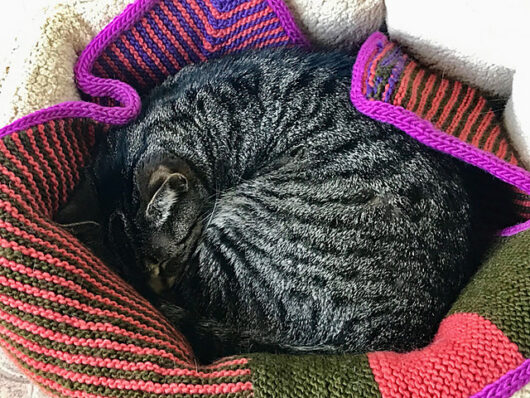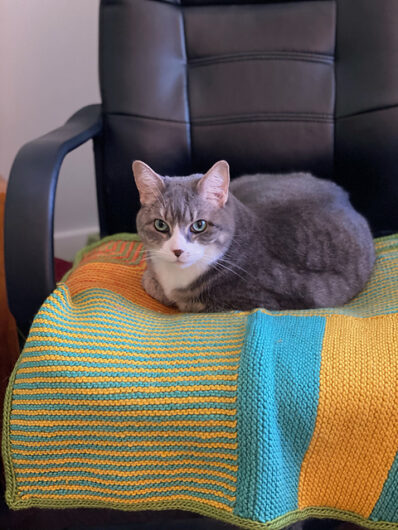I’ve a number of posts already on my exercises in color combinations that do double duty as cat-bed blankets. Instead of linking to the old posts, I’ve decided to include photos of the older ones after I show off my three new ones. And at the end I’ll tell you how I knit them.
First off, they work out great in the colorful line of Lamb’s Pride worsted, by Brown Sheep. What at first looked to me to be some very unlikely color combos turned out looking cool. And also cozy. Cozy enough that I’m beginning to think I might start saving the pieces up to someday piece together these squares to create a very colorful throw. That’s partly because all the cats I know already have one of these. When I knit with Lamb’s Pride worsted, on US size 8 needles, the piece takes about 3.5 skeins. And the result turns out to be a 24 inch square. During an especially mellow knit, the square approaches 25 inches.
The main three colors in this one are: M187-Turquoise Depths, M80-Blue Blood Red, and M02-Brown Heather. There’s also some M-10 Cream making an appearance.
Next up is another new one in M-120 Limeaid, Orange Creamsicle, and M-155 Lemon Drop. I have no notes on a color number for Orange Creamsicle. It was basically a quite-bright orange with some cream streaking. A check on the Brown Sheep website doesn’t list it as a current color. And that purple splotch in the corner of the mitered square is M-59 Periwinkle alternating with French Lilac.
For this next new one I used M-105 RPM Pink, M-38 Lotus Pink, M-120 Limeade, and French Lilac. French Lilac may have been some special run, or possibly even a “seconds” because my notes say the ball band had no color number designation. It’s the very vibrant purple-pink in this next square.
Now for a retrospective on squares I’ve blogged about before this. Here’s one in M-68 Pine Tree, “VM”-Eucalpytus, M-184 Pistachio, Orchid Blush, and (I think) a touch of M-59 Periwinkle at the end of the mitered square.
Next is M-113 Oregano, M-159 Deep Coral, Orchid Blush, and a smidge of M-59 Periwinkle again. Orchid Blush is still available on Brown Sheep’s website, but its color number doesn’t show up there.
Here’s M-155 Lemon Drop, Orange Creamsicle, M-187 Turquoise Depth, and Lemony Lime. Some of these color numbers are lost to the antiquities (apparently).
This next one is M-59 Periwinkle, M-105 RPM PInk, Lemony-Lime, with some Orange Creamsicle tossed in.
Here’s Ink Blue, Rosey Velvet, Pine Shadows, and Orange Creamsicle again.
Next up is an experiment, two colors. I don’t like it as well. Maybe that’s why I didn’t record the identifying numbers on the colors.
Based on the amount of each two colors used, review of my used stash photos suggests that the colors are M-22 Autumn Harvest and M-59 Blue Boy.
This next one is M159 Deep Coral, M-78 Aztec Turquoise, M169 Woodland Green, along with a touch of one of the purples.
Finally, before we get to the “how to,” this next one is another experiment. I’d purchased a major amount of Lana Grossa Fusione at a deep discount and thought I’d try a square. Fusione is a bulky weight, so I used a US size 9 needle (rather than an 8). It’s a typically pricey yarn spun in 30% cotton, 26% alpaca, 25% wool, 19% nylon. This one is headed out soon to my granddaughter. One of her baby dolls could use a new blanket.
It’s pretty. And very soft. I’m fairly confident that baby doll will love it.
So, here’s how I make these. I give credit to Donna Druchunas for the inspiration. Her pattern for a bulky-weight shelter-cat blanket, with half or 75% fewer stitches than my version, minus the final mitered square and minus the border I use can be found on her blog and is also accessible via Ravelry.
Here’s how I make mine:
I use a US size 8 needle and end up at a gauge of about 18 stitches and 34 rows per 4 inches, in garter stitch. If you prefer a different gauge you’ll need more (or less) than 3.5 skeins of Lamb’s Pride Worsted per square. For Square 1, cast on 48 stitches and work for 48 garter ridges (96 rows). Change colors every other row. There’s no need to cut the yarn. It’s best to be consistent about whether you choose to bring the new color over (or under) the working yarn. Keep a consistent tension as you change colors.
Square 2 is the wide stripe. Pick up and knit 48 stitches on the right side of Square 1. Work all pick-up of stitches looking at the right side (the public side) of the square. Work 16 ridges (32 rows) of Color 1, 16 ridges of Color 2, 16 ridges of Color 3. You will have to cut the yarn at the end of each 16-ridge section. Join the new color looking at the right side of the work.
For Square 3, pick up and knit 48 stitches along the left side of Square 2. Work Square 3 the same way you worked Square 1.
Square 4 is the mitered square. It’s my major modification of Duchunas’s version. With the right-side facing, pick up (and knit) 48 stitches on the left side of Square 3 and 48 stitches on the top of Square 1. Place a stitch marker to mark the middle (after you pick up the first set of 48 stitches). Count that picked-up row as Row 1. Knit across all 96 stitches for Row 2, a wrong-side row. Continue to alternate colors, starting with the next row, a right-side row. On each right-side row: knit to within 2 stitches of the center marker and knit two together. Slip the marker. Reverse the next stitch on the needle and then knit 2 together through the back loops (including the flipped stitch and the next one). Knit the remainder of the row. Continue to decrease this way at the center of every right-side row, eliminating 2 stitches each right-side row and knitting every wrong-side row. When you have 2 stitches left, knit them together.
Next, knit the border. Working in the round works well. Looking at the right side, pick up and knit 48 stitches on each side of each square, plus 1 stitch at each corner. Mark the corner stitch with a marker on each side of it. I use a 60 inch circular needle but a somewhat shorter needle will be OK. Continue working garter stitch in the round. That means you need to follow a knit round with a purl round. So, after the pick-up round, purl the next round. To keep the corners from curling, work mitered corners by knitting in the front and the back of each stitch on either side of the marked corner stitch on each right-side (knit) round. Bind off when you’re satisfied with the width of the border. Five or six garter ridges (10 or 12 rounds) works well. Knitter’s choice on whether to alternate colors or add a one-ridge stripe or just use one color. Also knitter’s choice on whether to bind off on a right-side or a wrong-side row. I prefer a knit bind-off on a right-side row.
Druchanas’s pattern called for an applied I-cord border. That’s an interesting look. And if you want the garter-stitch look without using mitered corners or circular needles, you can pick up stitches along each side, adding extra stitches to lengthen the border. Then you can sew the corners together.
Yipes. After all these words, maybe your eyeballs need a rest. Here’s some photo inspiration.
Cats really do like these. My theory is that it’s something about the 85% wool, 15% mohair mix. Or maybe cats just know warm wherever it’s to be found.


















You are so generous with your knitting !
Cats really do love wool, even wet. I learned this after leaving a still damp sweater blocking on the floor when i went to bed. Woke up to a lovely cat shape imprinted on my new sweater🥴
@Marty…Bad kitty!